R.M.S.
Mauretania (2) 1939 to 1965
Please Note: Firefox and some other Search Engines may not be suitable
Use Google Chrome for this Web Page to load perfectly!

Click
the logo above to reach the ssMaritime FrontPage for News Updates &
“Ship of the Month”
Please Note:
All ssMaritime and other related maritime sites are 100% non-commercial and
privately owned, thus ssmaritime is NOT associated with any shipping company or
any other organisation! Although the author has worked and been involved in the
passenger shipping industry for well over 60 years, but due to his old age and
poor health, he was forced to retire. Yet, he has completed well over 1,435
Classic Liners, Passenger-Cargo Liners as well as humble converted C3 converted
Migrant Liners, which has transported countless thousands folk to the new
world, as well on vacations’. I trust the features online will continue
to provide Classic Liner and Ship enthusiasts both the information they are
seeking, but more so provide a great deal of pleasure and relive many happy
memories!
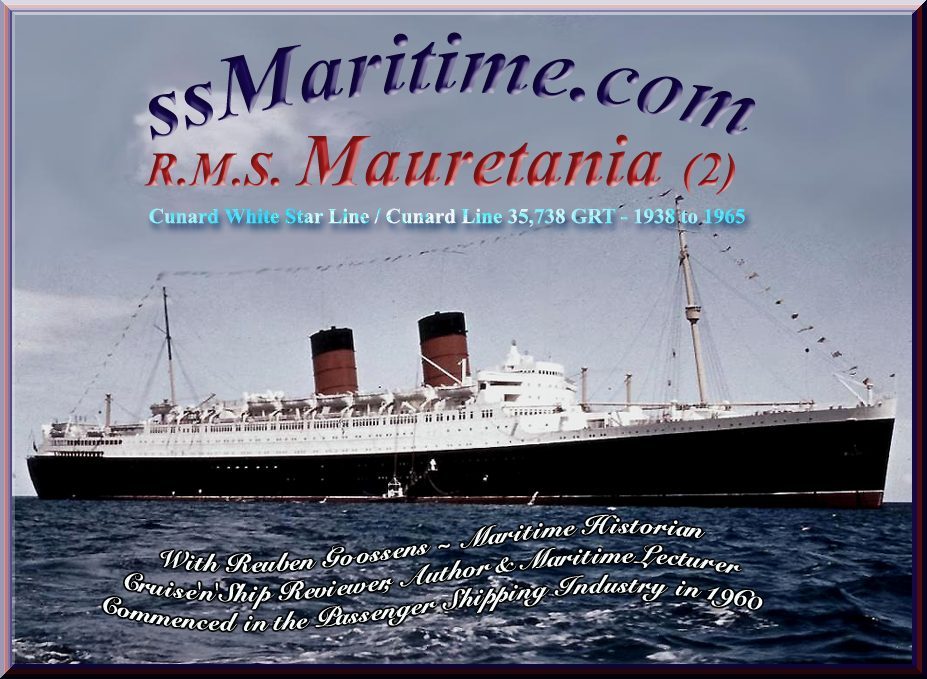
Please
Note:
Postcards, photographs & other images are either from the author’s
private collection or from my supporters.
Thus
a very special thank you to the very special ssmaritime supporters for sending
me their wonderful
photographs & images
for I could not have completed this feature to this point.
Introduction:
After decades of
prosperous transatlantic business, all shipping companies were suddenly faced
with great financial troubles when the great crash occurred in 1929. In fact
times became so bad for Cunard, that the two former rivals Cunard Line and
White Star Line decided to merge in 1934, forming the “Cunard White Star
Line.” Due to the merger, they were granted with greatly needed
government subsidies to complete the ship, which Cunard had commenced to build
back in December 1930. To date the ship was only known as; “Hull
534” and this great ship would eventually become the legendary R.M.S.
Queen Mary.
Although the Queen Mary
could now be finished with the merger, but it did not mean that the hard times
were over.
Cunard White
Star did not have the money to build further new ships and therefore they were
forced to rely on their old liners. It would not be until 1937 before the
Company was able to order a new ship to be constructed.
Building a Grand New Liner:
Due to
economics recuperating, Cunard White Star Line ordered their first new ship to
be built by Cammell Laird & Co. Ltd, Shipyards at
Birkenhead.
The first keel section was laid on May 24, 1937 on Number 6 slipway, which was
also birthplace of the H.M.S. Rodney, H.M.S. Ark Royal and the R.M.S. Samaria.
Work continued and it was on October 23, 1937 that Sir Percy Bates, the
Chairman of Cunard, announced that his wife Lady Bates would launch the ship on
July 28, 1938 and that it had been decided to name the new liner *Mauretania,
stating; “thus
reviving a name which has been made famous the world over by her distinguished
1906 predecessor.”
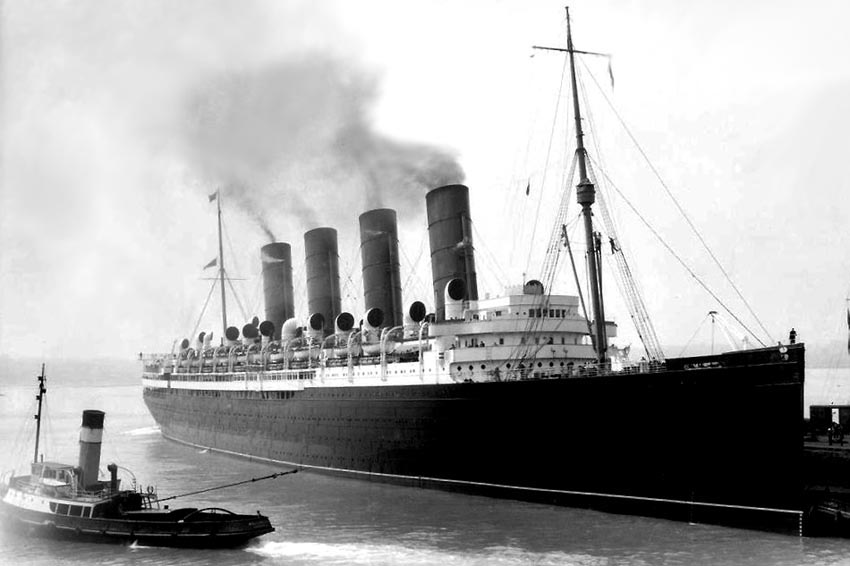
The
great R.M.S. Mauretania 1 built in 1906
Her
feature is now also online see the link at the bottom of the page
Very rapidly Cunard White Star Line commenced to promote their new Trans-Atlantic
liner, as she would be the very largest ever all English built Liner due to
commence sailing in 1939.
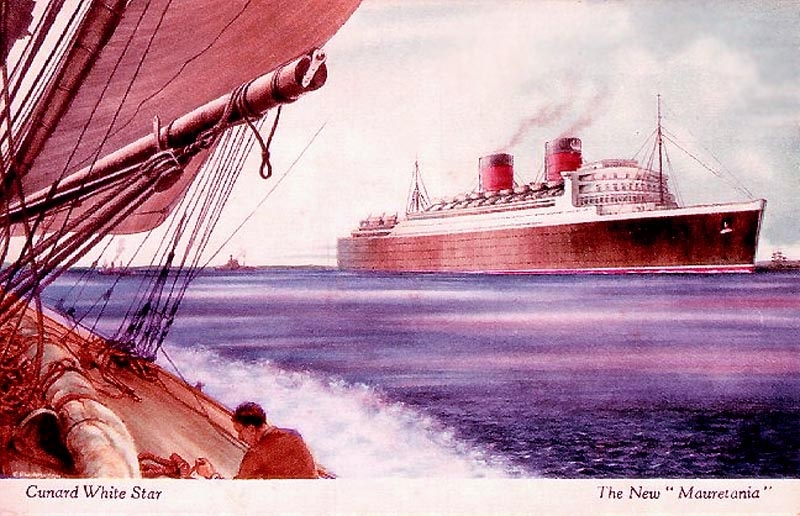
Cunard
White Star Line released this promotional postcard of the R.M.S. Mauretania (2) prior to
her launching
*In
relation to her name, when the 1906 Mauretania (1)
was sent to the breakers’ yard at Rosyth
in July 1935 her name removed from Lloyd’s Register, thus Cunard decided to safeguard her famous name for their new
forthcoming liner. For this reason Cunard approached
a local Southampton company “Red Funnel Steamers” and requested
their Directors if they would rename one of their excursion paddle
steamer’s “Mauretania” in order to
keep the name available for them. They were more than happy to oblige and the South
Coast
excursion steamer “Queen” was renamed “Mauretania”
from April 1, 1936 until November 1937, when the new ship was officially
registered.
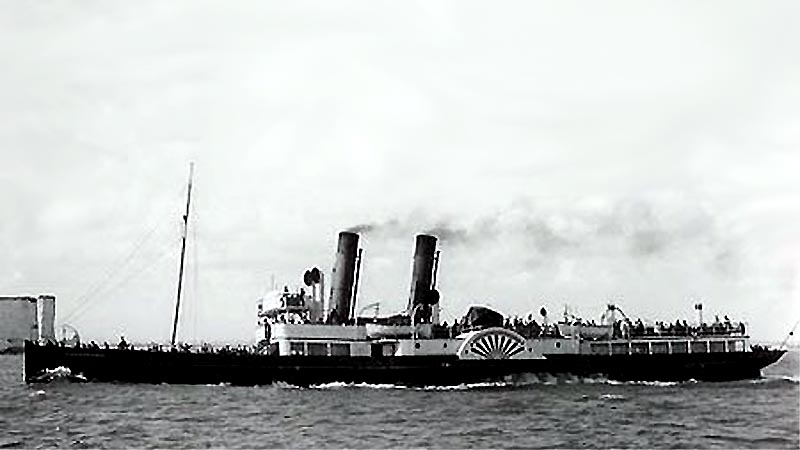
The South Coast excursion Steamer, which was renamed “Mauretania”
The Mauretania
would be when completed the largest ship to be constructed in England
at a projected gross tonnage of over 35,000 GRT (Gross Registered Tons). It is
true that bigger ships had been built before in the United Kingdom
however these liners had been built in either Scottish or Irish Shipyards.
Finally on
July 28, 1938, the day had arrived that the very first Cunard White Star vessel
was ready to be launched and workers and countless onlookers were at hand to
see the great sight. As had already been announced by Sir
Percy
Bates, the honour of christening
of the new liner was given to his wife, Lady
Bates.
At 12.15 pm Lady Bates officially named her the “Mauretania” being
a great name that naturally brought to Mind of the legendary *R.M.S. Mauretania
of 1906 the famed Blue Riband-holder, and she pressed the button that sent the
new liner into the water from No 6 slipway. Eight tugs awaited her and they
towed her to her fitting out berth.
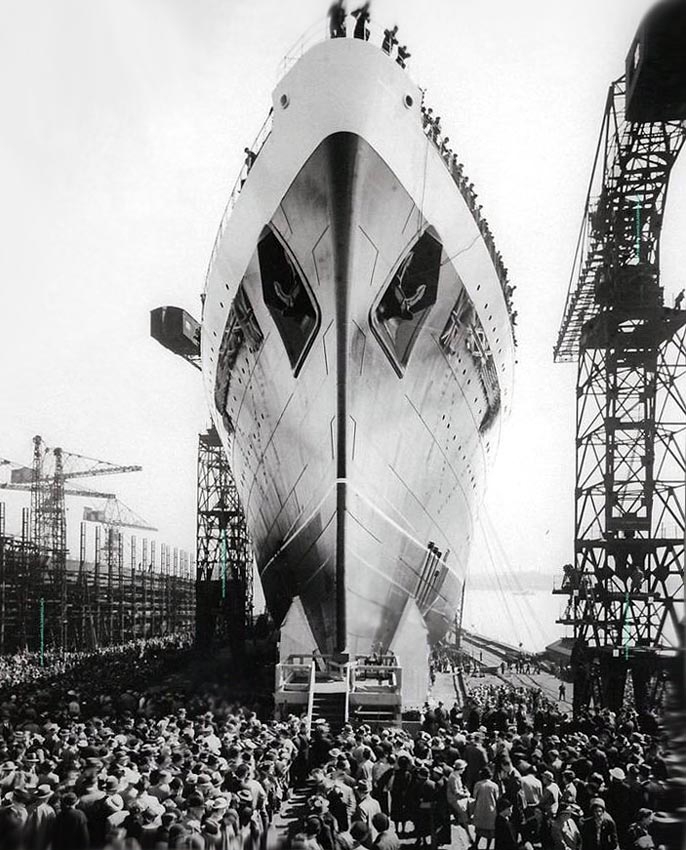
The
ships great bow towered above the official party and the massive crowd watching
her slowly slip into the water
From her
construction yard the eight tugs towed the Mauretania to the Cammell Laird Fit-Out berth for further work to be
completed, including her upper works and her interiors, as well as her masts
and funnels being fitted. However, she was located next to the H.M.S. Ark
Royal, the aircraft Carrier, which had preceded her by 15 months.
On May 14,
1939, after the ship had been placed in a wet basin, the Mauretania was taken out of Cammell Laird’s wet basin, and with the aid of six
tugs she was escorted through the Gladstone River Entrance and into the
Gladstone Graving Dock, being no mean navigational feat. It was here where her
50-ton rudder was fitted.
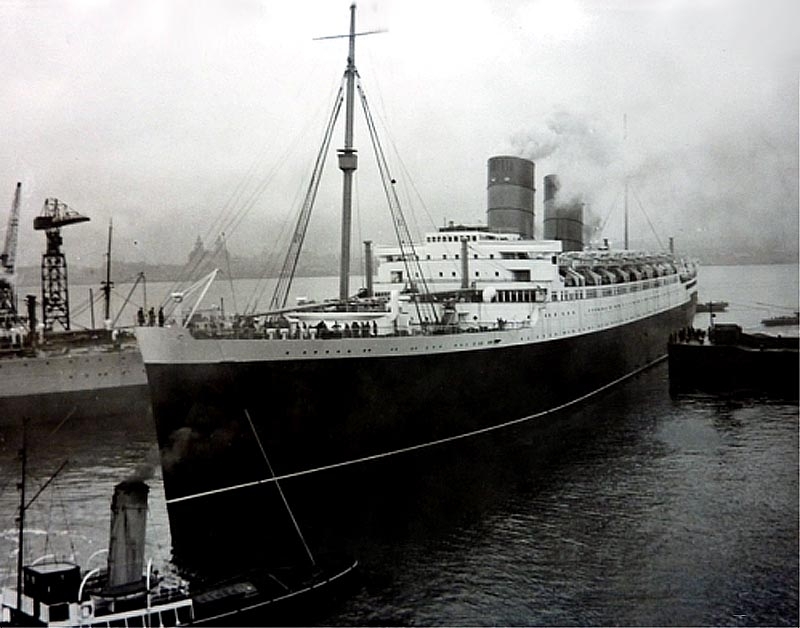
The Mauretania is seen leaving the Cammell Laird wet basin with the aid of six tugs
Some 17 days
later, on May 31 1939,, the Mauretania departed
Liverpool for her acceptance trials on the Clyde, with Captain
A.T. Brown,
RD, RNR, being in command. Her trials were run over the ‘Arran
Mile’ and the Mauretania
recorded a run of 25.34 knots at 47,800 SHP. Her trials were completed to
the satisfaction of the builders and the Cunard-White Star and her owners. The
Mauretania (2) returned to Liverpool
where she was formally handed over to Cunard-White Star. A very happy Sir
Percy
Bates, commented; “There
has never been a Cunard ship that has gone through her trials with less
trouble, with less fuss with almost an air of casual ease, than this ship has
done.” Statistically, the R.M.S. Mauretania 2 was the twelfth
largest and sixth fastest liner in the world in 1939.
Passengers & Interiors:
As time would
pass in the future, the R.M.S. Mauretania would always be considered as a somewhat
smaller version of the R.M.S. Queen
Elizabeth
as her overall design and profile was so very similar, as can be seen below.

This
illustration of the Mauretania
reveals the Queen Elizabeth
similarity, having that same beautiful hull and
a traditional cruiser
stern, two tall masts and funnels as well as a similar lifeboat and deck
arrangement
The Mauretania’s interiors were
superbly designed and her interiors featured what was known as the “Late
Art Deco-style,” which could be seen throughout each of the three
classes, although in a lesser degree in Third Class.
It had been
decided no to commence with a First Class, but instead the highest grade being
Cabin Class, which had 440 passengers, Tourist Class had 450 passengers, and
Third Class had 470. Looking after them were a good 780 to 803 officers and
crew. However, it need to be said that both Cabin and Tourist Classes were
equal to First and Second Class on the larger major Trans-Atlantic liners!

A
stylish Cabins Class Entrance Hall and a finely crafted Staircase
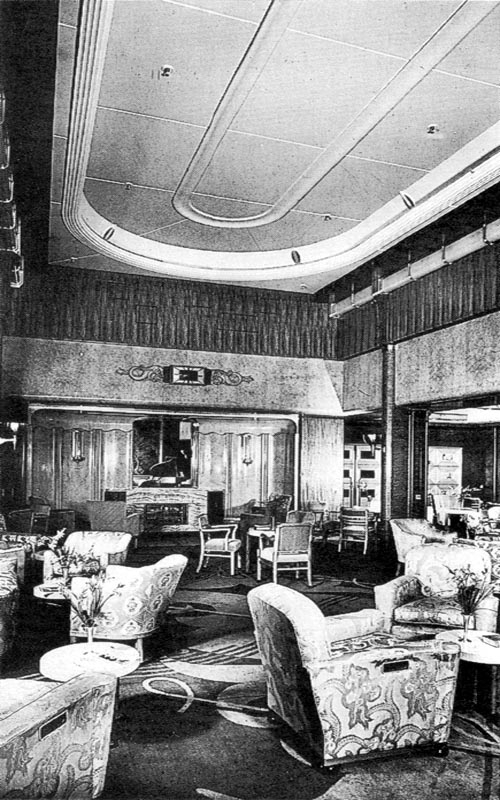
Above
& below: The Cabin Class Grand Hall was two
decks high in the middle
and was in fact far more grandiose
that these photographs reveal
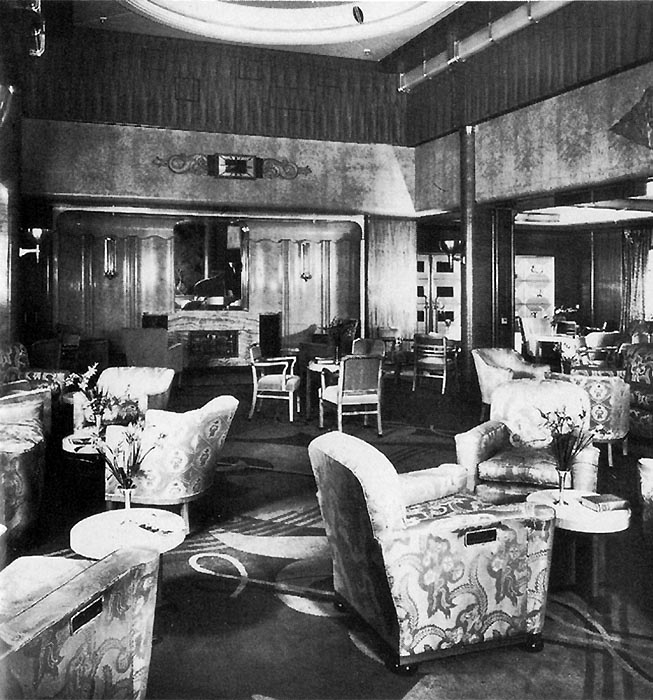
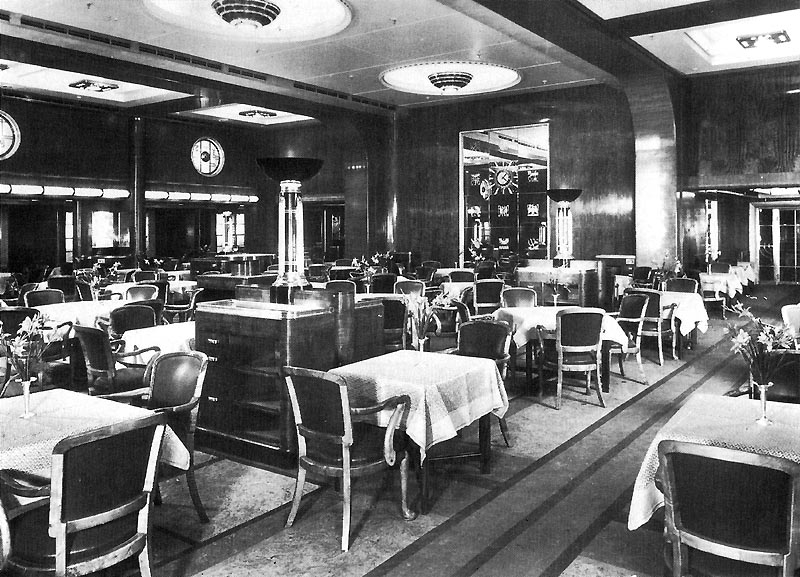
Here
we see a most comfortable and an elegant Cabin Class Dining Saloon, and which
does look so very British!
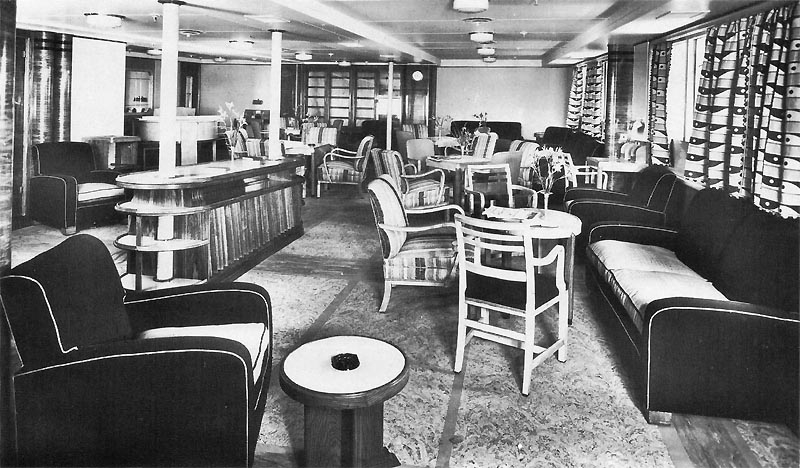
One
of the delightful Tourist Class Lounges with a bar placed along a sidewall
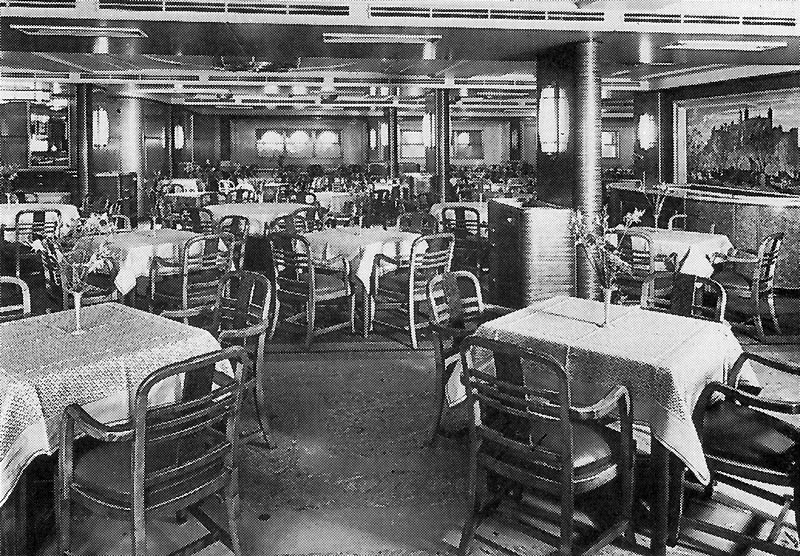
The
Tourist Class Dining Saloon
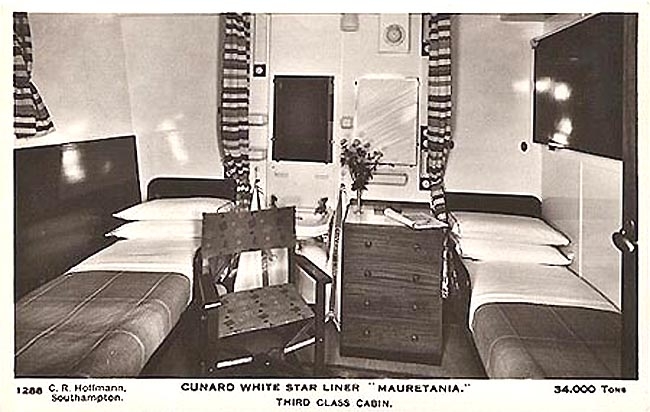
Considering
this is a Outside Third Class 2 or 3 berth cabin, it
certainly is of a high standard for the 1930!
Maiden Voyage & Early Voyages:
On Saturday
June 17, 1939 with a complement of a good 1,000 passengers aboard, the new
R.M.S. Mauretania (2) departed Liverpool for her maiden voyage under the
command of Captain A.
T. Brown,
who had delivered the 1906 Mauretania
(1) to the ship breakers in July 1935. The
R.M.S. Mauretania 2 sailed via Cobh Ireland
and after a very short stay to take on board some immigrants; she headed across
the Atlantic Ocean for New York.
She arrived at New York
early in the morning of Saturday June 24, and as she steamed up the Hudson where she
received that famous traditional New York
harbour welcome.
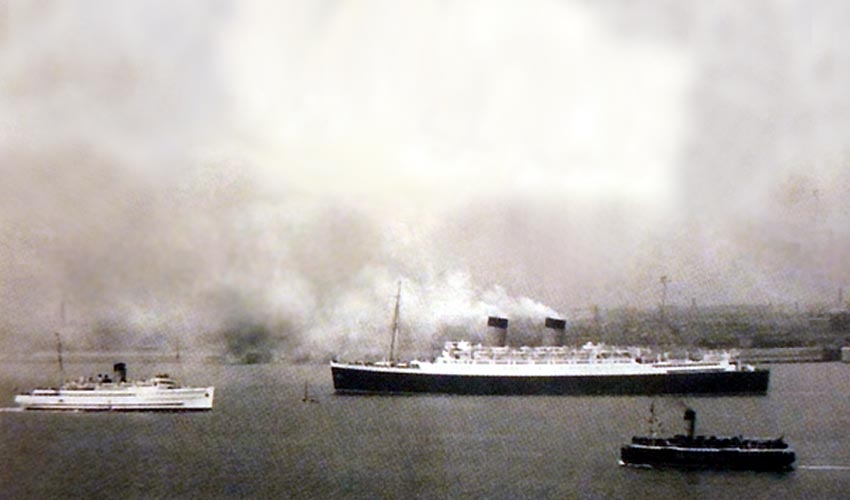
R.M.S.
Mauretania seen departing Liverpool for her Maiden Voyage to New York
The white vessel
forward of the liner is the Isle of
Man ferry Mona’s
Queen
Her
return voyage from New York
was to Southampton and a call to Cherbourg.
This time, she had a full complement of passengers and the Mauretania arrived
at Southampton
on July 7. For interest, her times for her maiden round-voyage were as follows:
Westbound: Mersey Bar Lightship to Ambrose
Channel Light Vessel at New York: 5 days, 21 hours &
40 minutes; Average speed 20.60 knots (including a stay at Cobh of
4 hours and 24 minutes).
Eastbound: Ambrose
Channel Light
Vessel to Cherbourg:
5 days, 22 hours, 22 minutes; average speed: 22 knots.
She again
headed to New York,
and after a one-week turnaround in “The Big Apple” the R.M.S.
Mauretania returned to Southampton.
Following her next westbound crossing, she called at Southampton, Le Havre and finally London
on her return trip. The Mauretania was the largest ship ever to navigate the Thames and use the Royal Docks.
It was on
August 6, 1939 that the Mauretania arrived in London’s
King George
V Dock.
There were over 100,000 people watching the almost three-hour passage from
Tilbury, with the London Pilot Harry Stowers on the
Bridge. The Mauretania
cleared the entrance lock with a mere 42 inches to spare on either side. The
new ship was the largest ever to enter the King George
V Dock,
and this was the one and only occasion she would.
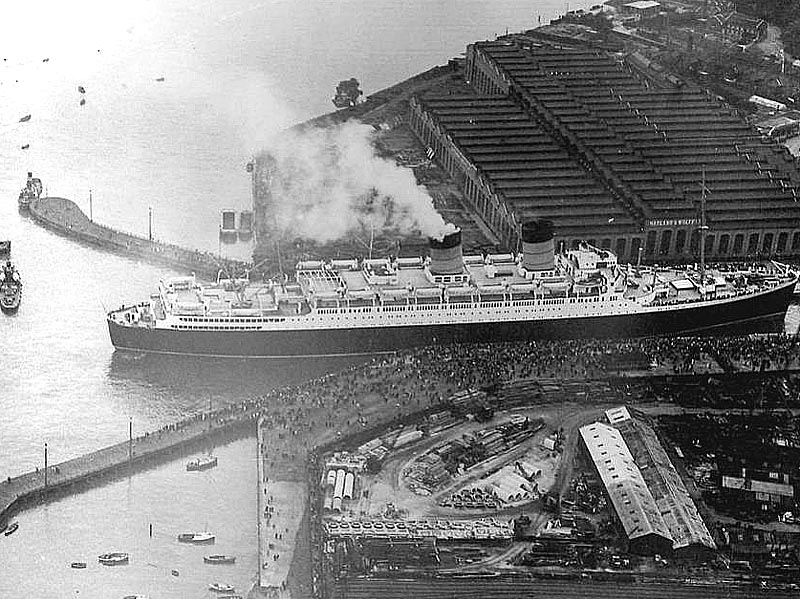
Mauretania
is seen entering London’s
King George
V Dock
on August 6, 1939
On August 12,
1939 the Mauretania departed London
for Southampton, Le Havre and headed for New York,
where she arrived on August 18, with 1,152 passengers. The next day she sailed
on a six-day cruise to Nova Scotia
and Bermuda.
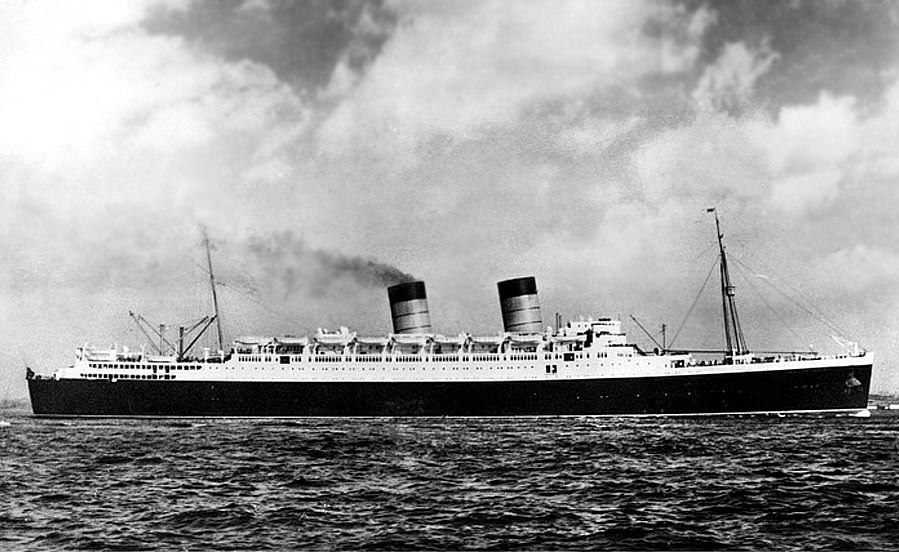
An
excellent starboard view of the R.M.S. Mauretania
H.M.T. Mauretania
the WW2 Troopship:
But sadly,
after a mere two months of Trans-Atlantic service, Hitler’s German Armies
invaded Poland and commenced what became one of the most hideous and murderous
wars waged by man, for Hitler and his madmen commenced to slaughter as many
Jews, those with Mental problems, Homosexuals, the disabled and Jehovah
Witnesses and any he did not like, but the Holocaust saw the slaughter of six
million Jews and an equal number of other poor souls, let alone soldiers who
died because evil people allow a mad man take control. This was World War Two.
As the
situation in Europe was rapidly deteriorating, after a seven-day turnaround in New York
the H.M.T. Mauretania departed on August 26, with 740 passengers on board, for
close to her departure there had been 262 cancellations. Then, the news came
that Germany
had invaded Poland
on September 1, 1939 was received in mid-Atlantic, and the Mauretania was
ordered to proceed directly to Southampton,
and not call at Cobh.
She arrived at Southampton
on the very day that war was declared; September 3, 1939.
On her return
she was requisitioned by the Government. The Mauretania was armed with two
6-inch (150 mm) guns and some smaller weapons, whilst she was painted in
battle grey, and she was despatched to America
by the end of December 1939.
For three
months the Mauretania lay idle in New York,
docked alongside the Queen Elizabeth, Queen
Mary,
and the French Line's Normandie, until had been decided to use her as a
troopship. On March 20, 1940 the H.M.T. Mauretania departed from New York bound for Sydney
Australia,
sailing via Panama.
She had an exciting voyage out to Australia
via Bilbao,
San Francisco
and Honolulu,
tracked for much of the way by the enemy and having to evade concentrations of
U-boats that were known to be lying in wait for her. In Sydney
she would be converted for her new trooping role. This conversion work was
carried out in April
and in May and then she left Sydney
as part of one of the greatest convoy’s ever mustered for the transport
of troops. The convoy consisted of the Queen Mary, Queen
Elizabeth,
and the Aquitania, with 2,000 troops on board the H.M.T. Mauretania bound
for the River Clyde as she sailed via South Africa.
Other notable liners in this great convoy were Empress of
Britain, Empress of Canada, Empress of Asia, and the famous Dutch
liner Nieuw Amsterdam.
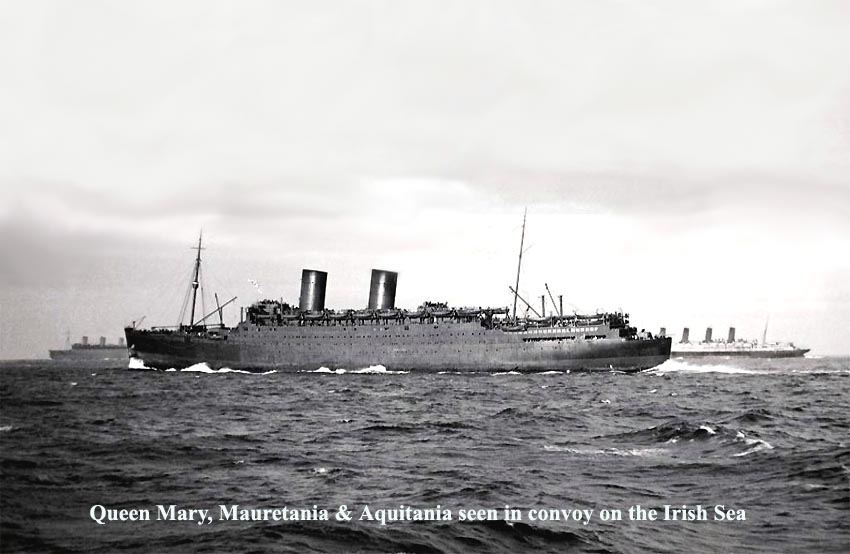
The
H.M.T. Mauretania seen in Convoy and in great company!
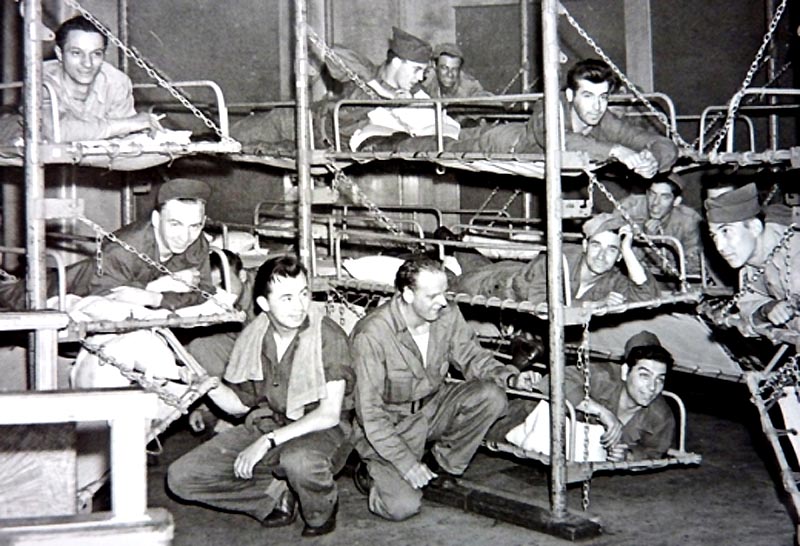
Soldiers
slept in simple bunk bed style of accommodations, but beds in this photograph
happened to be in a Cabin Class
lounge as vertical mahogany panels can be seen on the walls
During the
early stages of the war H.M.T. Mauretania transported Australian troops to Suez, India
as well as to Singapore
but later she mostly served in the North Atlantic.
Like Aquitania she amassed well over 50,000 sea miles during the course of
her early war duties, first crossing of the Indian Ocean, then working the Atlantic with American and
Canadian troops and finally serving in the Pacific.
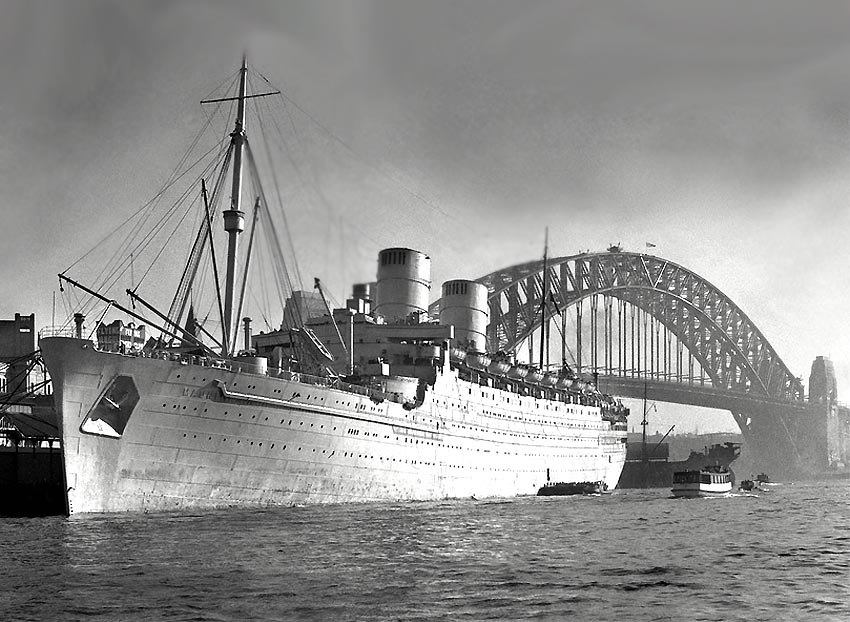
Troopship
H.M.T. Mauretania is seen in her wartime grey livery in Sydney
One of her
wartime voyages, of 28,662 nautical miles (53,082 km) duration, took
her right around the world, taking 82 days to complete. During this epic voyage
she established a speed record for the crossing time from Fremantle, Australia
to Durban, South Africa.
The 4,000-mile (6,400 km) distance was covered in 8 days and 19 hours at
an average speed of 21.06 knots (39.00 km/h). Another wartime troop
transport voyage began in New York on May 10, 1943 and ended in Bombay on June
24, 1943, with ports of call being, Trinidad, Rio de Janeiro, Cape Town and
Diego Suarez. However, on January 8, 1941 she was involved in a minor collision
with the American tanker S.S. Hat Creek in New York
harbour.
Once the war
had concluded, the H.M.T. Mauretania made several further voyages for
the Government repatriating troops. This mainly saw the ship heading to Canada
and Singapore.
In addition, the H.M.T. Mauretania took the first dedicated sailing
of English War Brides and their children (400 wives and 354 babies)
being taken to Canada to join their husbands, she departed Liverpool on February
5, 1946 and they landed at Pier 21 at Halifax. She returned to Liverpool with 2,752 German
Prisoners of War on board.
The now highly
regarded Trooper, the H.M.T. Mauretania made one last voyage to the Far East
from Liverpool to Singapore
on June 26, 1946 and it proved to be yet another voyage for the record books:
Mersey Bar Lightship to Sultan Shoal in Singapore
a total of 8,426 miles, completed in 16 days, 20 hours and 31 minutes. However
her homeward voyage was even faster, being completed in 16 days, 1 hour and 30
minutes. Altogether she had sailed 16,863 miles at an average speed of 23.11
knots, a great testament to her engineers, considering the ship had had no
maintenance over the past six-years!
The H.M.T.
Mauretania's very last voyage as a troopship was from Liverpool once again to Halifax,
Nova Scotia,
but this voyage was indeed very special, for who was on board? It was no other than Field Marshall Viscount
Montgomery.
Finally after
six long years, she may have been weather beaten, scarred, but a very proud
ship lovingly known as the H.M.T. Mauretania
and she finally arrived home in Liverpool for the last time in that
wartime grey livery, on September 2, 1946 where she disembarked 600 passengers.
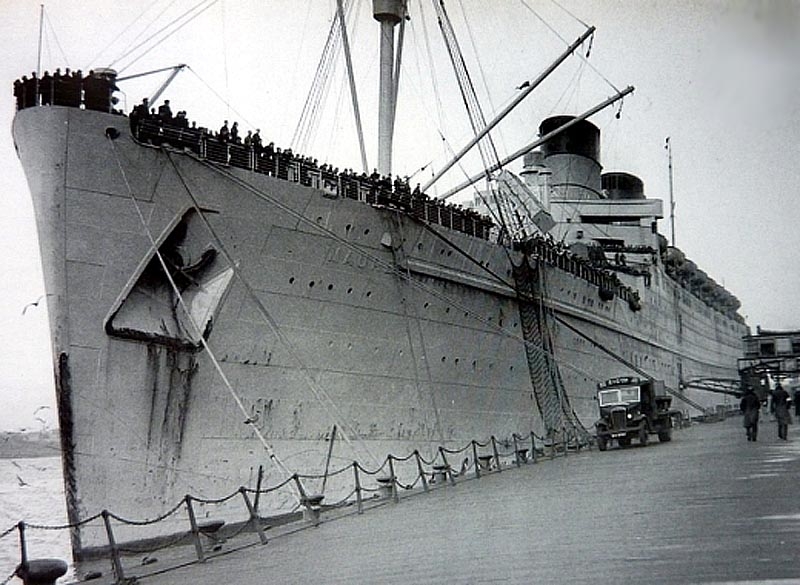
H.M.T.
Mauretania is seen here berthed at the Princes Landing Stage, disembarking the
last of her wartime passengers
As a troopship
H.M.T. Mauretania travelled a grand total of 542,446 miles
(870,000 km) and carried 350,178 troops. Although the H.M.T. Mauretania
was not designed to be an exceptionally fast ship, and during her war duty her
engines had received little attention for her six long years of service
operating as a troopship. However, she achieved a turn of speed in 1945 making
the passage from Bombay
to the UK
via the Cape
at an average speed of 23.4 knots. On September 2, 1946 she returned to Liverpool and she was officially
released from Government service. and she was sent to
Gladstone Dock to be reconditioned by Cammell Laird
& Co., to be returned return to Cunard White Star service.
Return to Being a Luxury Liner:
Within a few
hours of disembarking her 600 passengers at the Princes Landing Stage in
Liverpool the Mauretania
was moved into the Cammell Laird Gladstone Dock to
commence the huge process of restoring the ship back to her designed role as a
luxury Trans-Atlantic liner.
Cammell Laird had a workforce of some
1,500, many of whom had helped build the ship, for her restoration was almost
like starting over again. The rusty grey wartime paint had to be sandblasted
off, a great deal of weathered decking had to be replanked
with new teak planks, worn machinery had to be renewed or completely replaced
as well as the gun emplacements having to be removed. In addition there was
furniture and fixtures that had been stored, be it close by or as far away as Sydney
Australia. All
had to be obtained and carefully restored. Also, the wartime ballast of 400
tons of pig iron and 700 tons of sand had to be removed. In the meantime, the
Mersey Docks & Harbour Board’s floating crane Mammoth removed the
76-ton aft funnel on September 23, 1946 to allow access to the engine room. In
total the ship refit cost £1 million pounds and Cunard White Star Line
announced on March 2, 1947 that the R.M.S. Mauretania would return in all her
glory to service on April 26, 1947.
The, the as
good as new R.M.S. Mauretania departed Liverpool on April 18, 1947 on a special
two-night “Shakedown Cruise” to the Hebrides for 400 special guests
of the Company. However, it seemed that the British weather conspired to make
this one of the liner’s most challenging of voyages. Heeding gale
warnings, Captain R.
G. B.
Woollatt
brought his ship off the Mersey Bar on April 21, by then, however, the winds
were so fierce that the Mauretania was not able to proceed up the sea channels
to Liverpool and she was forced to seek shelter in “Moelfre
Bay,”
off the north coast of Anglesey.
Her anchors were dragging, and therefore the Mauretania had to ride out the
storm on the Irish Sea.
It was not until April 24 that she was able to return alongside Princes Landing
Stage. Thus the Shakedown Cruise did not prove to be a great success, except
for those who did not mind a heavy sea! In Liverpool, her crew and shipyard
workers rapidly completed final work required, including storing within
forty-eight hours to keep the ship to schedule.
The heavily
booked R.M.S. Mauretania finally departed on what was likened to being her
second maiden Trans-Atlantic voyage from Liverpool to New York,
departing on April 26, 1947. Although she had another rough and a somewhat slow
crossing and she arrived in New York
on May 2, several hours late.
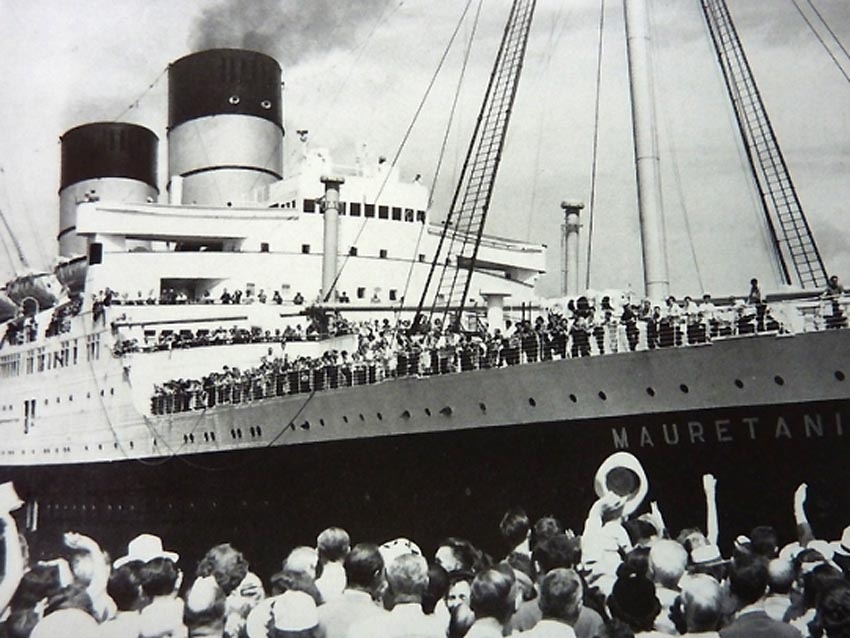
The
R.M.S. Mauretania was given a huge send-off on her first post-war commercial
departure from Liverpool
The Mauretania was never in more
demand, and during the balance of 1947 carried 23,997 passengers, or better
than 90% passenger capacity. Even when the R.M.S.
Queen Mary
returned to service in August 1947, the R.M.S. Mauretania continued to
supplement the ‘Queens’ with Southampton, Cherbourg, Cobh to New York
sailings every seventeen days. But, she never returned to London
and her previous cargo capacity was never fully utilised again.
Mauretania the Part Time Cruise Ship:
In January
1948 she commenced to operate the first of five cruises from New York to the West Indies. Whilst cruising she
would accommodate no more than 750 passengers in a One Class configuration. In
addition for her new role, four of her lifeboats were replaced by motorised
tenders, as at some Caribbean
ports passengers required to be transferred ashore and back to the ship per
tender.
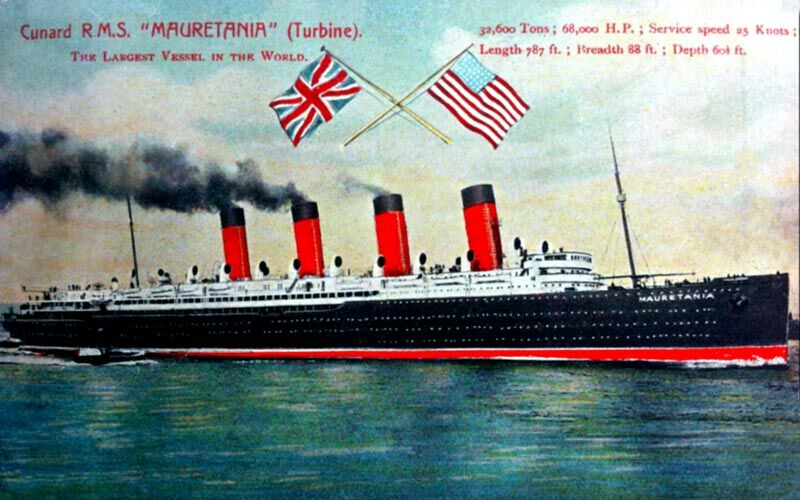
A
fine colour postcard of the R.M.S. Mauretania
These so-called
‘dollar earning cruises’ assisted the “shattered British
economy.” But for the rest of the year she continued on the Southampton
to New York
service and during the Northern Hemisphere winter months she operated cruises
from New York.
When Mauretania was taken in for her annual overhaul at Liverpool in December 1957 the
opportunity was taken to fit air conditioning throughout the ship.
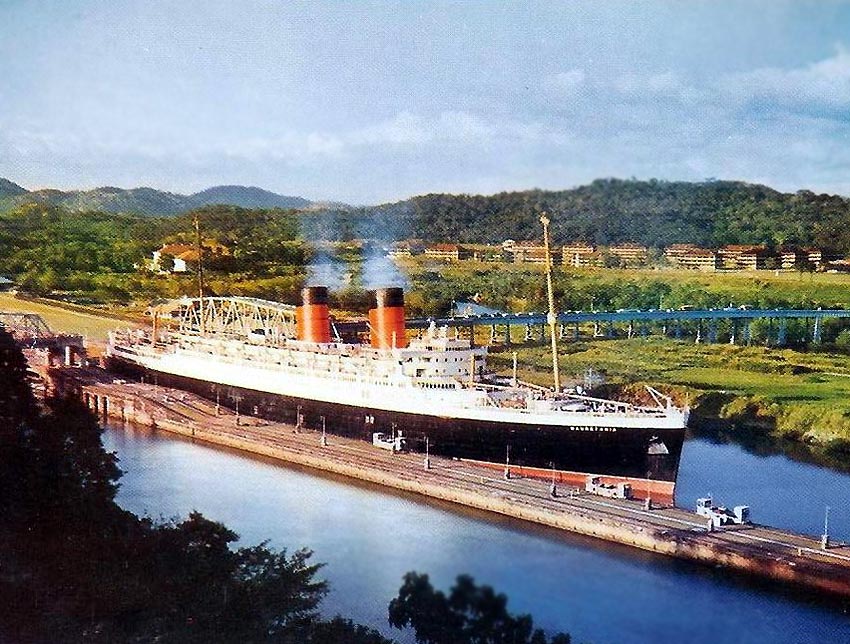
The
Mauretania is seen in one of the Locks, during one of her Panama Canal cruises
The R.M.S.
Mauretania soon gained her own loyal following and between 1947 and 1957 she
made some 260 Atlantic crossings, transporting a good 241,286 passengers, being
an average passenger loading of 82.5%. She sailed without any faults or problem
and she proved to be a far steadier sea boat than the two much larger
‘Queens,’ and she certainly had none of the newer R.M.S. Caronia’s of 1948, engine problems and handling
difficulties.
In 1950 the Mauretania was transferred to the
sole ownership of Cunard Line
In October
1957, the now middle-aged liner Mauretania returned to Liverpool where she would be
given a comprehensive £500,000, three-month refit. This would see the ship
receive the installation of air-conditioning throughout the ship.
Air-conditioning certainly made the popular Mauretania more competitive on the Caribbean cruise trade.
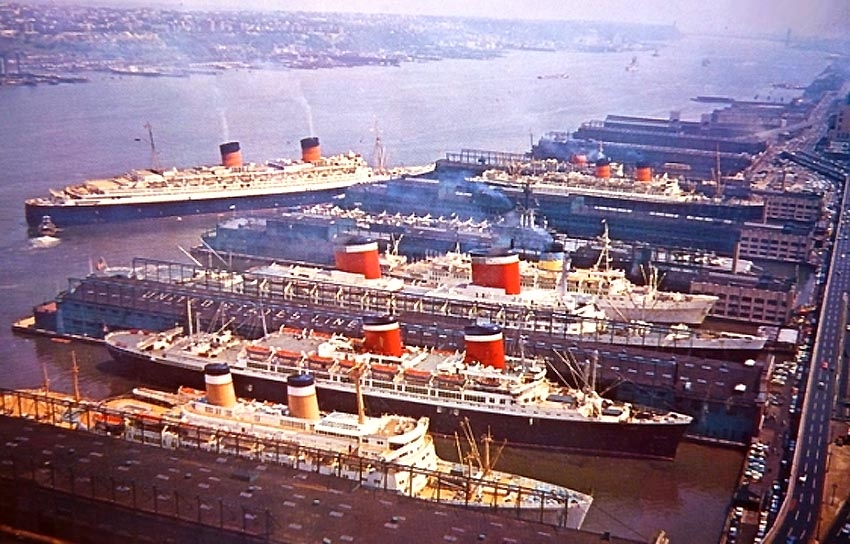
This
is one of those amazing New York
Harbour
port photographs. R.M.S. Mauretania is
seen berthed at the top Pier 92
Coming in
is R.M.S. Queen Elizabeth heading for
Pier 90, the smaller white ship is the Greek Line TSS
Olympia, next to her
is the United States
Lines
S.S. Unites
States
and the S.S. America, finally the
American Export Lines S.S. Independence
However, as
with all shipping on the Atlantic and world-wide passengers were difficult to
find for liner services, as air travel was becoming more and more popular, for
it was both faster and fares were coming down rapidly! Thus, Mauretania’s services on
the Trans Atlantic run was becoming very much a surplus, with the ship
frequently carrying no more than just a third of her total capacity. Thus
In 1962 the
H.M.T. Mauretania made no profits for her owners, and so it was decided that
she would be used almost only for cruising. She was painted in light green,
like the Caronia, giving her a more leisure look. Her
passenger capacity was reduced a little to make her more suitable as a cruise
ship. The following year, on March 28th 1963, she started her new
Mediterranean service between New
York, Cannes,
Genoa
and Naples.
But this was a new route for Cunard and the competition was hard. The Italian
Line's Leonardo
da Vinci
and Cristoforo Colombo stole almost the whole
clientele, and Cunard soon returned the H.M.T. Mauretania to her old service in
the Caribbean.
She made periodic appearances on the transatlantic run, but spent the most of
her time cruising in warmer waters.
The Cruising Green Mauretania in 1962:
In October
1962 the Mauretania it was decided to Drydock her at Southampton
for a complete transformation and a refit. Her accommodation was revised as
follows’, 406 First Class, 364 Cabin Class, and 357 Tourist Class. In
addition, she was repainted in Caronia’s
“Cruising Green.”
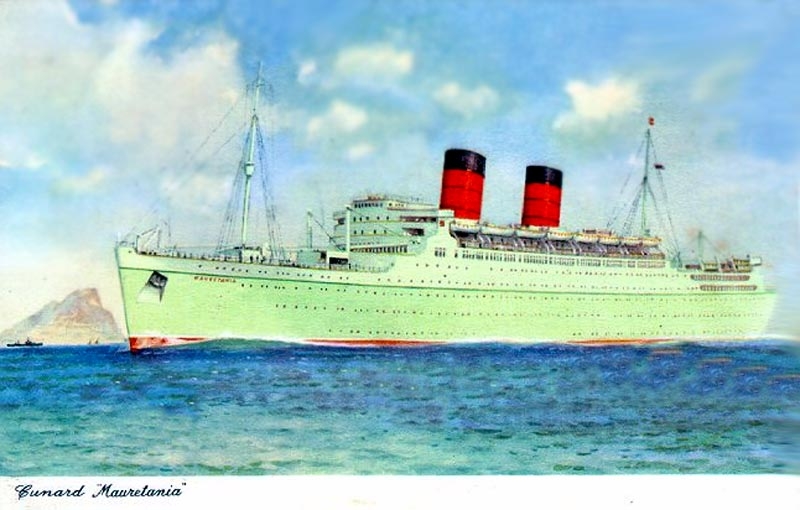
Cunard
released this postcard of the new look Mauretania
The all-new
looking R.M.S. Mauretania emerged two-and-a-half months later, yet what was
somehow that “Caronia’s image”
detracted from the beautiful classic lines of the Mauretania. That rather bilious
green hull came to symbolise Mauretania’s
declining years.
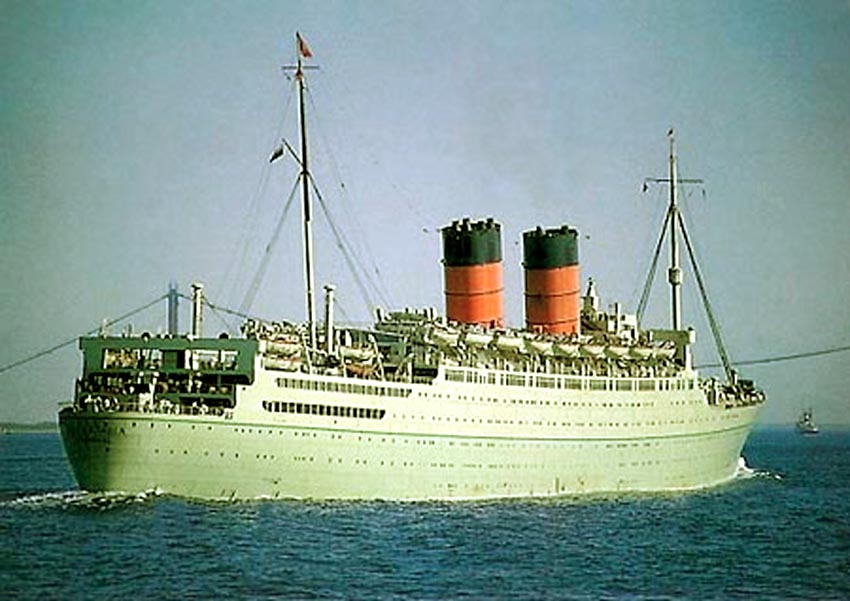
The
new look Green Mauretania seen in New York
Then, in
August 1962 Cunard Line decided to commence a new cruise operation from New York to the Mediterranean, being a 41-day
cruise. She operated this cruise in February and March 1963, with the
Mauretania departing New York
on March 28, with 676 passengers, calling at Gibraltar, Cannes, Genoa, and Naples.
She departed Naples on April 19, with a mere 123 passengers bound for New York,
However, there was a slight improvement, as her average load factor was sadly a
miserable 14% on this new Mediterranean cruise service. One of the big problems
was that Italy
and the United
States were
protecting their subsidised services, not granting permission for emigrants to
travel on the Mauretania.
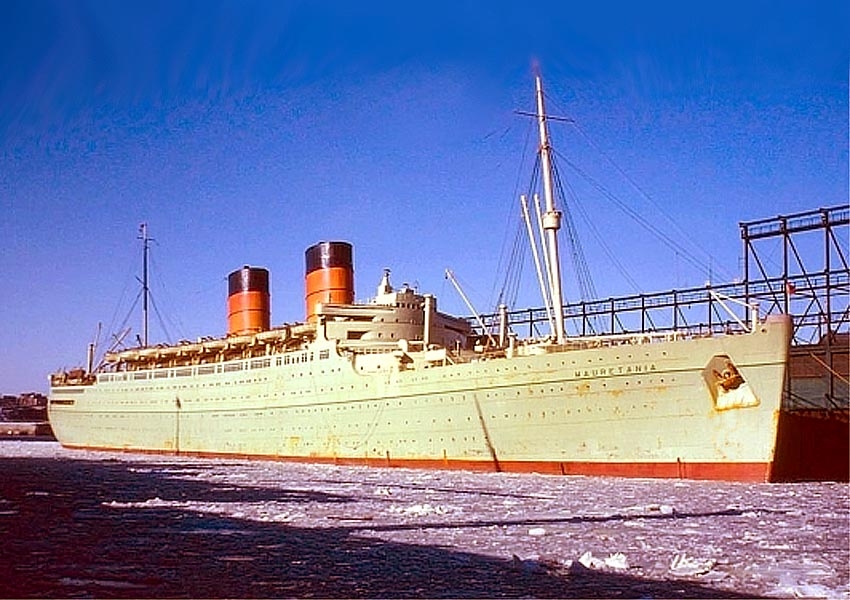
Mauretania
is seen in New York’s
Cunard Pier 90 in icy wintery conditions
She resumed
her summer Trans-Atlantic services but now she was sailing from Southampton to
New York, but loadings proved to be very poor, thus for the 1964 cruise season
she was again employed on the popular New York to the West
Indies cruise again, which had generally good loadings. However
that was only for a short period of the year
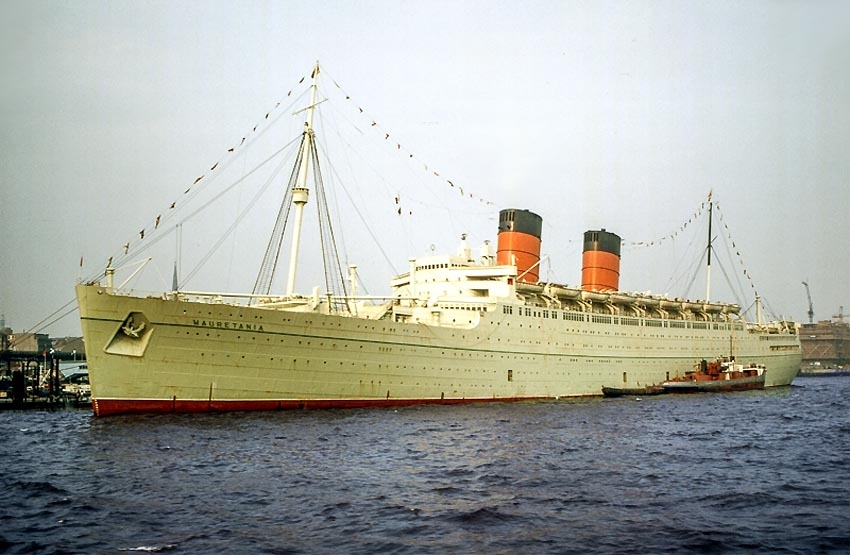
The
Mauretania is seen here in the port of Hamburg Germany
in around 1964/1965
Photograph by & Copyright © Helmut-Groening
The R.M.S.
Mauretania was sailing with the other Cunard Passenger Liners and were doing so as Cunard was losing a good £1 million in the
first six months of 1965. Therefore, finally on February 10 1965 Cunard sadly
announced that due to “excessive costs to keep the Liner up to Company
standards,” the Mauretania
would be withdrawn in November.
R.M.S.
Mauretania departed New York
for the final time on September 12 1965 for an epic last voyage, having some
307 passengers on board, who would spend sixty-one days and 14,600 miles
visiting some thirty-one ports. Although it being an already melancholy cruise,
it was made sadder with the announcement on October 4, that the Mauretania would soon be broken
up. She would be the largest British liner to be scrapped since the R.M.S.
Aquitania.
Thus, it was
on September 15, 1965 that Cunard announced that she was to be decommissioned
and sold to the highest bidder. In fact, even before R.M.S. Mauretania returned
to Southampton on November 10, a
highest bidder had already been accepted at 360,000 made by “Thomas
W. Ward”
at Inverkeithing on the Firth of Forth, Scotland.
R.M.S.
Mauretania departed New York
for the final time on September 12 1965 for an epic last voyage, having some
307 passengers on board, who would spend sixty-one days and 14,600 miles
visiting some thirty-one ports.
Her Final Days:
Although it
being an already melancholy cruise, it was made sadder with the announcement on
October 4, that the Mauretania
would soon be broken up. She would be the largest British liner to be scrapped
since the R.M.S. Aquitania.
But as the
R.M.S. Mauretania returned home for the very last time and sailed up
Southampton Water on November 10, the weather was suitably dismal as the
Mauretania was flying her paying-off pennant from her aft Mainmast!
Destoring commenced, and a few items
were removed whilst Mauretania was in Southampton
and she was then taken away. On November 23rd the H.M.T. Mauretania
arrived at Ward's
ship breaking yard in Inverkeithing,
Scotland.
There she was cut up during the years of 1965 and 1966.
The
great R.M.S. Mauretania, which had served both; Cunard White Star Line and then
Cunard Line, as well as her country during WW2, and now she had finally come to
the end of her days after 27 wonderful years of service.
This Great
Lines and Cruise Ship departed Southampton at 12 noon on November 20, 1965
under the commanded by Captain John Treasure Jones (also was the captain of
the R.M.S. Queen Mary on her final voyage), who navigated the mud
straits of the Forth without tugs, and she arrived alongside The Ward's wharf
at Inverkeithing on November 23. Captain
Treasure
Jones
rang “Finished with Engines” on the telegraph and the life then
ebbed from the once great Liner!
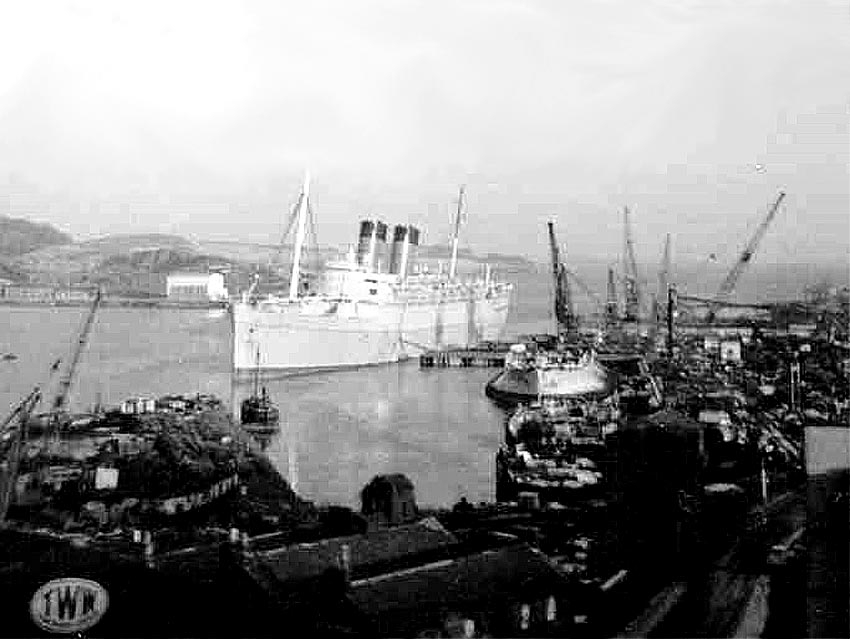
The Mauretania is seen at the Thomas
W. Ward
Ship breakers yard on November
23, 1965
R.M.S.
Mauretania Specifications and Details:
Official Number:…………….………166267.
Signal Letters:……………………….GTTM.
Operators:………………………………Cunard
White Star Line
- 1938 to 1950.
……………………………………………….Cunard Line:1950 to 1965
Owned by::………………………….…Cunard
Steamship Co. Ltd.
Port of Registry:……………………..Liverpool.
Builder:…………………………………..Cammell Laird of Birkenhead, England.
Launched:……………………………….July 28, 1938.
Maiden Voyage:………………………June
17, 1939
Gross Tonnage:………………………35,738
GRT, 19,654 Net.
Length:……………………………………772ft
- 235m.
Beam:……………………………………..89.6ft
- 27m.
Draught:………………….………………30.10ft
- 9.39m.
Propulsion:………………………………6
Parson Single Reduction Steam Turbines.
Screws:…………………………………..Twin,
42,000 SHP.
Speed:…………………………………….23 knots, maximum of 25.34 knots.
Passengers:…………………………….440 Cabin Class, 450 Tourist Class, and 470 Third
……………………………………………….Class - as built.
……………………………………………….406 First Class, 364 Cabin Class, and 357 Tourist Class
……………………………………………….after 1962 refit.
Crew:………………………………………780
to 802.
Fate:……………………………………….Sold to be broken up November 1965.
Broken up at:………………………….Thomas W.
Ward shipbreaking
Yard in Inverkeithing,
………………………………………………..Fife in Scotland
in 1966.
Remembering the Grand Dame
Of the Atlantic
~ R.M.S Mauretania
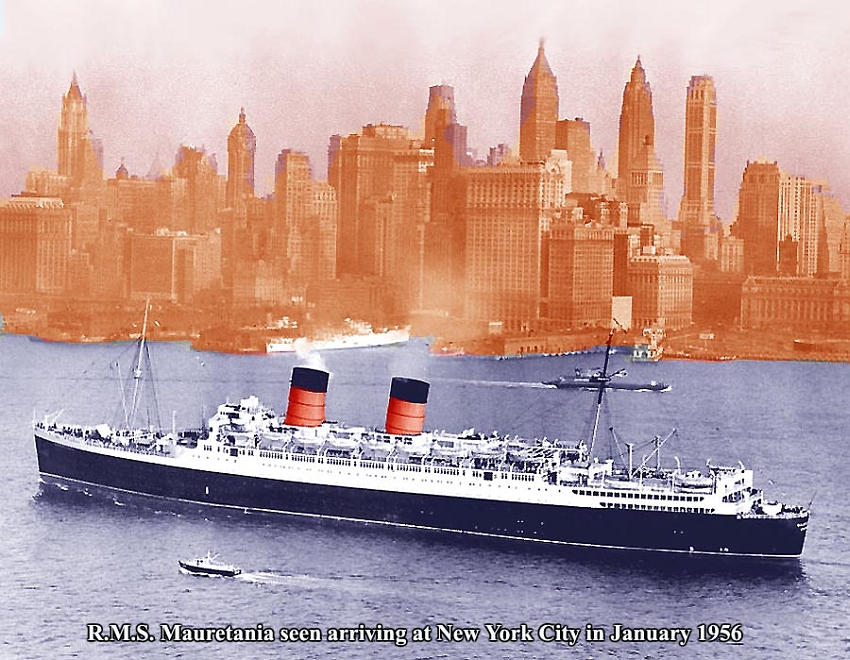
Also Remembering her
as the World War Two Hero that Came Home!
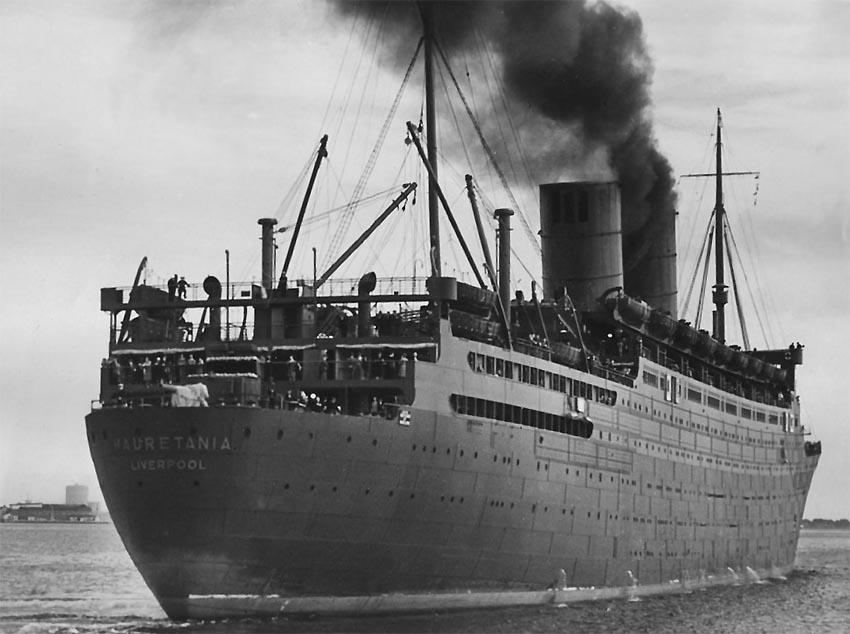
An
excellent stern view of H.M.T. Mauretania as she returns home having travelled
a
grand total of 542,446 miles
(870,000 km) and carried 350,178 troops
Also
see … R.M.S. Mauretania (1) – Now Online
***********************************
“Blue Water Liners sailing to the distant
shores.
I watched them come, I watched them go and I watched them
die.”
Return to the ssMaritime MAIN INDEX
ssMaritime.com & ssMaritime.net
Where you will discover over 1,435 Classic
Liners & the 1914 built MV Doulos
Story
The
Author has been in Passenger Shipping & the Cruise Industry for over 60
years!
In addition he was the founder of
“Save the Classic Liners Campaign” in 1990.
For interest: Sadly an email service to ssMaritime is no
longer available, due to the author’s old age and chronic illness as well
as being disabled, etc. In the past ssMaritime received well over 120 emails
per day, but Mr.
Goossens
can no longer handle the same. He sincerely regrets this!
Please
Note: ssmaritime and associated sites are 100%
non-commercial and the author seeks no funding or favours of any shape
or form, never have and never will!
Photographs on ssmaritime and associate
pages are by; the
author or from the author’s private collection. In addition there are
some images that have been provided by Shipping Companies and private
photographers or collectors. Credit is given to all contributors. However,
there are some photographs provided to me without details regarding the
photographer/owner concerned.
This notice covers all pages; although, and I have done my best to ensure that all
photographs are duly credited and that this notice is displaced on each page,
that is, when a page is updated!
ssMaritime is owned & ©
Copyright by Reuben Goossens - All Rights Reserved
































